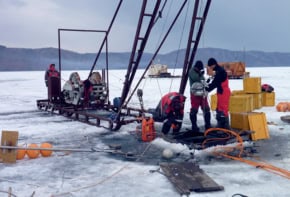
A new method of separating isotopes using lasers has been unveiled by scientists in the US. In the short term, the technique could be used to purify lithium-7, which is used to cool nuclear reactors. However, in principle, the method should be applicable to isotopes of a wide range of elements.
Isotopes are separated for a variety of uses. Perhaps the best-known use is nuclear medicine, whereby a patient is injected with or ingests a radioactive substance as a tracer. To avoid having to give the patient more of the substance than is necessary, the radioisotope of interest is first purified.
Isotopes are also used in the nuclear industry. Lithium, for example, is added to the water in a pressurized water reactor as a buffer against the boric acid used to control the reaction. In the future, physicists have also proposed reactors that are cooled by molten lithium fluoride. However, both applications run into problems because naturally occurring lithium-6 can produce radioactive tritium when exposed to neutrons. Tritium is easily absorbed by the body in the form of water, and so to avoid health risks, it is necessary to use only pure lithium-7 – which is the most common isotope of the element.
Better than COLEX?
Today, lithium-7 is purified using the column exchange method (COLEX), which relies on the fact that lithium-6 has a greater affinity for mercury than lithium-7 does. Lithium is first dissolved in mercury and the solution is then reacted with water. The aqueous solution of lithium hydroxide that forms at the top of the column is mostly lithium-7, whereas the mercury-rich amalgam at the bottom contains mostly lithium-6. The lithium-6 can then be removed from the amalgam and the mercury reused – at least in principle. In reality, however, any process using large quantities of mercury is fraught with hazards. Indeed, nearly 10% of the 10 million kilograms used to date in the COLEX process remains unaccounted for – with 330,000 kg of the toxic metal believed to have been lost in waste streams, evaporation and spills.
While a more environmentally friendly process would certainly be welcome, candidates are rather thin on the ground. Using lasers to separate isotopes with different nuclear magnetic moments has been suggested before, but the energy requirements have always been prohibitive. “Previous methods of enrichment using lasers were primarily based on ionization of the atoms, and that required several different wavelengths and very high-power lasers,” says Mark Raizen of the University of Texas at Austin, who led the research. “Ionizing an atom is a bit like climbing up a ladder that’s slippery – you have to do it fast to avoid slipping down.”
Optical Pumping
Raizen and fellow physicist Bruce Klappauf decided instead to investigate a subtler effect called optical pumping, whereby the absorption of laser light can change the magnetic state of a nucleus, making it move in a specific direction in response to a magnetic field. Different isotopes are excited at slightly different frequencies, and lasers emit at only one, very precise frequency, so this provides a very efficient way of changing the magnetic states of some isotopes but not others, and thus to separate the two. “The importance of this is that it can be done with an economy of light, which is important when one considers the scalability of the method,” says Raizen.
To show that the method should be possible, the pair used a computer simulation to calculate the trajectories of different isotopes of lithium in a magnetic field. They found that the two isotopes would indeed follow different paths and therefore could be separated (see image).
Raizen believes the method could be used for isotopes of other elements, although he concedes there may be problems with the very heaviest elements – actinides such as uranium. “We just don’t know,” he says.
“Highly speculative”
Nuclear physicist Magdi Ragheb of the University of Illinois at Urbana-Champaign is more circumspect. “The work attempts to combine two techniques used in isotopic separation: the electromagnetic separation or calutron method and the laser isotope-separation method,” he says. “It is highly speculative and discusses multiple options for its possible implementation. A trajectories simulation does not guarantee its feasibility without concrete experimental evidence.”
The research is published in New Journal of Physics.



